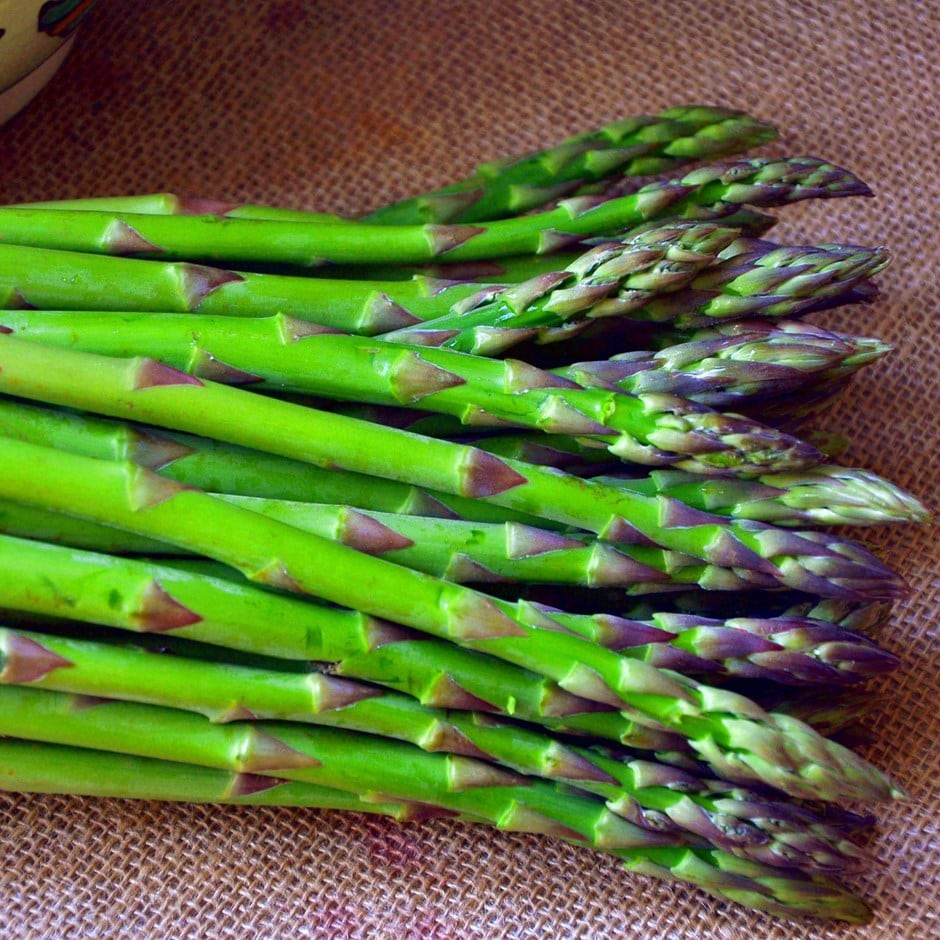asparagus 'Connover's Colossal'
asparagus crowns
- Position: full sun
- Soil: any moderately, fertile soil
- Rate of growth: average
- Hardiness: fully hardy
An excellent variety with bright green spears and deep purple tips that produces an exceptionally high yield. The crowns are best planted between March and May, and though a few spears can be cut the following year, it is best left for two years so that it can grow into a strong plant. 'Connover's Colossal' has been awarded an Award of Garden Merit by The Royal Horticultural Society.
Your asparagus will arrive as bare-root crowns and should be unpacked and planted as soon as possible. Traditionally Asparagus are planted in spring, but the crowns can be planted at any point from autumn to spring. They need a sunny spot, shelter from strong winds and well-prepared soil that ideally has had lots of manure or compost added in the previous autumn. Good drainage is important too, so if your soil is heavy and wet, it would be advisable to grow them in a raised bed.
Prepare the bed well (ideally well before planting) by removing all the weeds and digging in lots of well-rotted manure or composted organic matter. When planting, dig a trench approximately 30cm wide and 20cm deep and work a little more organic matter into the base of the trench. Using the excavated soil, create a 10cm tall, arched ridge down the length of the trench and sit the crowns on top. Allow 30-45cm between each plant. Spread the roots out to form a star-shape and cover them with the remaining soil, leaving the tops of the crowns just visible. Subsequent rows should be at 45cm intervals with staggered planting. Immediately after planting, water thoroughly and mulch with a generous layer of composted organic matter. During the growing season keep them well fed with a dressing of general purpose fertiliser and make sure the bed stays free of weeds. The first spears will appear soon after planting, but it is important that these are not cut, but allowed to develop into feathery stems throughout the summer. These can be cut back to just above ground level after they have started to die back in autumn. Before the new spears appear in subsequent years, make a ridge of soil over each row and apply a dressing of general purpose fertiliser. If you can, try to resist harvesting the spears, which appear in the second year too, as the plant should be left to develop a robust crown before you begin cutting the spears in their third year.
Prepare the bed well (ideally well before planting) by removing all the weeds and digging in lots of well-rotted manure or composted organic matter. When planting, dig a trench approximately 30cm wide and 20cm deep and work a little more organic matter into the base of the trench. Using the excavated soil, create a 10cm tall, arched ridge down the length of the trench and sit the crowns on top. Allow 30-45cm between each plant. Spread the roots out to form a star-shape and cover them with the remaining soil, leaving the tops of the crowns just visible. Subsequent rows should be at 45cm intervals with staggered planting. Immediately after planting, water thoroughly and mulch with a generous layer of composted organic matter. During the growing season keep them well fed with a dressing of general purpose fertiliser and make sure the bed stays free of weeds. The first spears will appear soon after planting, but it is important that these are not cut, but allowed to develop into feathery stems throughout the summer. These can be cut back to just above ground level after they have started to die back in autumn. Before the new spears appear in subsequent years, make a ridge of soil over each row and apply a dressing of general purpose fertiliser. If you can, try to resist harvesting the spears, which appear in the second year too, as the plant should be left to develop a robust crown before you begin cutting the spears in their third year.
- Humans: Skin allergen; fruits harmful if eaten

